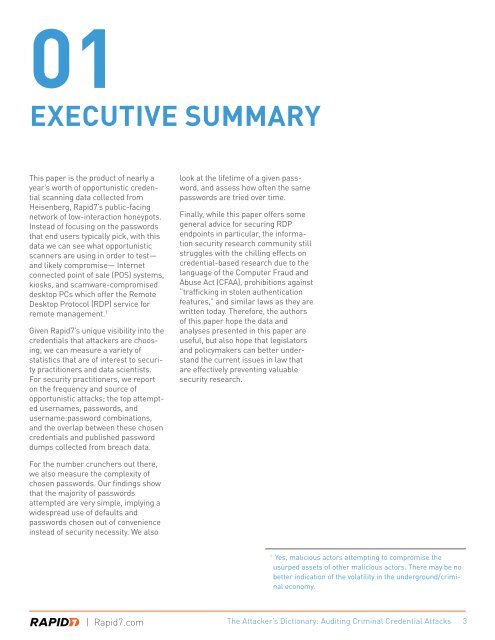The Attacker’s Dictionary
rapid7-research-the-attackers-dictionary rapid7-research-the-attackers-dictionary
RAPID7 The Attacker’s Dictionary Auditing Criminal Credential Attacks Contents 01 02 03 04 05 06 07 08 09 Executive Summary 3 Bad Passwords Are Bad 4 Heisenberg Honeypots 5 Event Frequency Traffic Analysis 8 Collected Credentials 10 Interesting Credentials 12 Password Complexity and Provenance 21 Solving These Problems 24 About Rapid7 26
01 EXECUTIVE SUMMARY This paper is the product of nearly a year’s worth of opportunistic credential scanning data collected from Heisenberg, Rapid7’s public-facing network of low-interaction honeypots. Instead of focusing on the passwords that end users typically pick, with this data we can see what opportunistic scanners are using in order to test— and likely compromise— Internet connected point of sale (POS) systems, kiosks, and scamware-compromised desktop PCs which offer the Remote Desktop Protocol (RDP) service for remote management. 1 Given Rapid7’s unique visibility into the credentials that attackers are choosing, we can measure a variety of statistics that are of interest to security practitioners and data scientists. For security practitioners, we report on the frequency and source of opportunistic attacks; the top attempted usernames, passwords, and username:password combinations, and the overlap between these chosen credentials and published password dumps collected from breach data. look at the lifetime of a given password, and assess how often the same passwords are tried over time. Finally, while this paper offers some general advice for securing RDP endpoints in particular, the information security research community still struggles with the chilling effects on credential-based research due to the language of the Computer Fraud and Abuse Act (CFAA), prohibitions against “trafficking in stolen authentication features,” and similar laws as they are written today. Therefore, the authors of this paper hope the data and analyses presented in this paper are useful, but also hope that legislators and policymakers can better understand the current issues in law that are effectively preventing valuable security research. For the number crunchers out there, we also measure the complexity of chosen passwords. Our findings show that the majority of passwords attempted are very simple, implying a widespread use of defaults and passwords chosen out of convenience instead of security necessity. We also 1 Yes, malicious actors attempting to compromise the usurped assets of other malicious actors. There may be no better indication of the volatility in the underground/criminal economy. | Rapid7.com The Attacker’s Dictionary: Auditing Criminal Credential Attacks 3
- Page 1: The Attacker’s Dictionary Auditin
- Page 5 and 6: 03 HEISENBERG HONEYPOTS Heisenberg
- Page 7 and 8: var td_2F = new td_0g(“4818a8896d
- Page 9 and 10: Figure 3: Events Per Day by Country
- Page 11 and 12: Figure 6: Top 10 Country Network Or
- Page 13 and 14: Figure 7: Top 10 Usernames administ
- Page 15 and 16: Top Passwords for the Top Ten Usern
- Page 17 and 18: Top Usernames Associated with the T
- Page 19 and 20: Figure 12: Distinct Passwords per U
- Page 21 and 22: 07 PASSWORD COMPLEXITY AND PROVENAN
- Page 23 and 24: Figure 15: Password Lifetimes Compl
- Page 25 and 26: would almost certainly run afoul of
01<br />
EXECUTIVE SUMMARY<br />
This paper is the product of nearly a<br />
year’s worth of opportunistic credential<br />
scanning data collected from<br />
Heisenberg, Rapid7’s public-facing<br />
network of low-interaction honeypots.<br />
Instead of focusing on the passwords<br />
that end users typically pick, with this<br />
data we can see what opportunistic<br />
scanners are using in order to test—<br />
and likely compromise— Internet<br />
connected point of sale (POS) systems,<br />
kiosks, and scamware-compromised<br />
desktop PCs which offer the Remote<br />
Desktop Protocol (RDP) service for<br />
remote management. 1<br />
Given Rapid7’s unique visibility into the<br />
credentials that attackers are choosing,<br />
we can measure a variety of<br />
statistics that are of interest to security<br />
practitioners and data scientists.<br />
For security practitioners, we report<br />
on the frequency and source of<br />
opportunistic attacks; the top attempted<br />
usernames, passwords, and<br />
username:password combinations,<br />
and the overlap between these chosen<br />
credentials and published password<br />
dumps collected from breach data.<br />
look at the lifetime of a given password,<br />
and assess how often the same<br />
passwords are tried over time.<br />
Finally, while this paper offers some<br />
general advice for securing RDP<br />
endpoints in particular, the information<br />
security research community still<br />
struggles with the chilling effects on<br />
credential-based research due to the<br />
language of the Computer Fraud and<br />
Abuse Act (CFAA), prohibitions against<br />
“trafficking in stolen authentication<br />
features,” and similar laws as they are<br />
written today. <strong>The</strong>refore, the authors<br />
of this paper hope the data and<br />
analyses presented in this paper are<br />
useful, but also hope that legislators<br />
and policymakers can better understand<br />
the current issues in law that<br />
are effectively preventing valuable<br />
security research.<br />
For the number crunchers out there,<br />
we also measure the complexity of<br />
chosen passwords. Our findings show<br />
that the majority of passwords<br />
attempted are very simple, implying a<br />
widespread use of defaults and<br />
passwords chosen out of convenience<br />
instead of security necessity. We also<br />
1 <br />
Yes, malicious actors attempting to compromise the<br />
usurped assets of other malicious actors. <strong>The</strong>re may be no<br />
better indication of the volatility in the underground/criminal<br />
economy.<br />
| Rapid7.com <strong>The</strong> <strong>Attacker’s</strong> <strong>Dictionary</strong>: Auditing Criminal Credential Attacks 3



